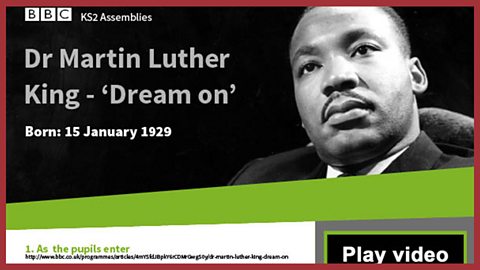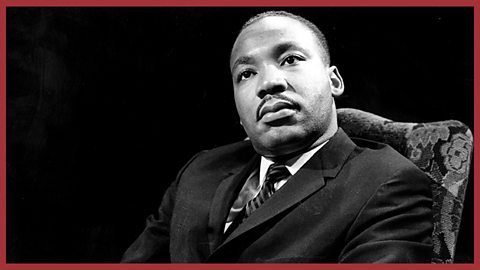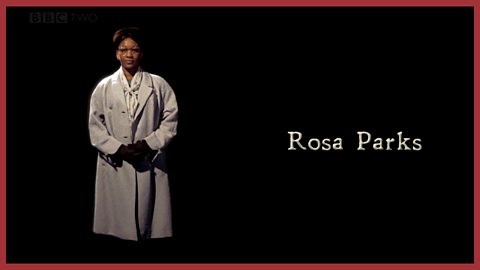In short...
Themes: Fairness; injustice; the rights of minorities; peaceful change; inspirational leaders.
Summary: This assembly is especially appropriate for Martin Luther King Day (third Sunday of January to coincide with his birthday, 15/01/1929) and Black History Month. Dr King's 'I have a dream' speech was delivered on 28 August 1963 at the Lincoln Memorial in Washington DC to a crowd of about 250,000. It was the culmination of the 'March on Washington for Jobs and Freedom' and is a key moment in the Civil Rights movement.
Resources: . This assembly includes and a video clip (below).

The video
A woman remembers how, as a girl, she was taken by her father in 1963 to Washington to hear a man talk. At first she couldn't understand why her father would drag her along to hear a man giving a speech that seemed to go on and on. She remembers how the crowd began to respond to the speaker and how as he brought his speech to its climax the crowds began to shout and cheer - herself included.
The memory of Dr Martin Luther King's speech - 'I have a dream' - has stayed with her across the yearsâŠan inspiration to carry on striving for justice and freedom for everyone.
Duration: 6' 05"
Final speech: 'âŠAnd I say: "Amen to that." '
Video questions
- The storyteller speaks 'some of the most famous words anyone has ever said: I have aâŠ' What? ('âŠa dream.')
- What year was it when the storyteller was taken to hear the speech? (1963)
- Where does the story take place? (Washington DC - capital city of the USA)
- Who was making the speech that day? (Dr Martin Luther King)
- The speech suddenly became more exciting when the speaker spoke about what and what? ('Hope' and 'freedom')

Key links
Download / print the assembly framework ready for use

Click to display the image of Dr King full-size.


Suggested framework
1. Entry music
Play your chosen music. You might consider 'We shall overcome' or music from the Southern States of America or a blues track. Display the image of Dr Martin Luther King (see link above).
2. Introduction
Introduce the video by asking if anyone has heard of Dr Martin Luther King (and if it is MLK day, âwhy today is specialâ). You may wish to use the following form of words⊠'Can anyone tell me who this picture is of? [Allow answers]
The picture was taken 1961 and it shows Dr Martin Luther King. Dr King was born on the 15th of January 1929 and lived in AmericaâŠwhere every year there is a public holiday to remember and celebrate his life.
At the time Martin Luther King lived, much of America did not allow the same rights to all its citizens - for example, a black person might not be allowed to go to the same places or do the same things as a white person. Dr King devoted his life to finding peaceful ways to struggle against that injustice and became a figurehead for what is known as the Civil Rights Movement.
He is particularly famous for a speech he gave - one of the most famous speeches of all time - in which he outlined his vision for a fairer, more just society for everyone.
Today we call it the 'I have a dream speech' and in our story a woman remembers how, as a child, she was taken by her father to hear that famous speechâŠ'
3. The video
Play the video. The duration is 6' 05" and the final words are: 'âŠand I say: "Amen to that." '
4. After the video
Ask pupils to sit in silence for a few moments to think about what they have seen and heard.
5. Time to talk
Ask children to tell you what they think is the most important thing to take away from the story. You could use the Video questions as prompts. You may also wish to share the following information with the group: i) Dr Martin Luther King was awarded the Nobel Peace Prize in 1964, aged just 35; ii) he was assassinated in 1968.
6. Opportunity to sing
If your assembly is to include a song this would be a good time to include it. Suggestions from ±«Óătv collections below.
7. Opportunity for reflection
Think about the message of Dr Martin Luther King.
Do you try to treat everyone fairly?
How can you make life better for someone today?
8. Opportunity for prayer
Use your standard form of address ('Dear God', 'Lord Jesus', etc) and:
We thank you for the life of Dr Martin Luther King and what we can all learn from it.
Help us to remember that, in the words of Dr King himself: Darkness cannot drive out darkness; only light can do that. Hate cannot drive out hate; only love can do that.
Amen.

Suggested songs
Song: 'Keep the golden rules' (All about our school, no 5. Vocal version)
Chorus:
Every dayâs a good day
When we keep the golden rules.
Then weâll get on in a good way
With everyone at school!
Show respect for one another
And different points of view,
And take good care of each other
In everything we do.
Verse 1:
Theyâre all there for a reason,
So everything is cool,
And every dayâs a good day
When we keep the golden rules!
Chorus:
Verse 2:
There are rules for playing every sport
And every kind of game,
To get along together
We need rules just the same!
Chorus:
Every dayâs a good day
When we keep the golden rules.
Then weâll get on in a good way
With everyone at school!
Show respect for one another
And different points of view,
And take good care of each other
In everything we do.
And take good care of each other
In everything we do.

Related links

Assembly frameworks on related themes
Rosa Parks - Black History Month. collection
KS2. Celebrating the life of Rosa Parks and exploring themes of justice and equality.

Mary Seacole. collection
KS1/KS2. Black History; significant lives; prejudice; determination; caring for others.
